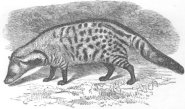 The Large Indian civet (Viverra zibetha), known in the shorter form of Indian civet, can be found in places of Indochina all the way to South China, but for the record, they are also in Vietnam, Hainan, Malay peninsula, and Nepal. These civets frequent scrub lands, grasslands and the thick forests. It is also a fact that they like staying near human establishments.
The Large Indian civet (Viverra zibetha), known in the shorter form of Indian civet, can be found in places of Indochina all the way to South China, but for the record, they are also in Vietnam, Hainan, Malay peninsula, and Nepal. These civets frequent scrub lands, grasslands and the thick forests. It is also a fact that they like staying near human establishments. An ordinary individual's weight is from 5 to 11 kilograms. Large Indian civets have dark spots at the body, and black/white stripes at the sides of its neck, and the tail possesses black rings surrounding it.
The female Large Indian civet is polyestrous, that is, they could breed at anytime within the year, and a typical litter has 2 to 4. These newborns are born at a hole (ground) or in vegetated areas. The newborn Large Indian civet would be able to open the eyes in a period of 10 days. Weaning is at 1 month, and in case you are wondering about the parents' role in rearing, the male does not. Only the female parents attend to the young.
Basically, they are nocturnal and solitary beings. In essence, they are terrestrial, yet they could climb as well. One marks his own place via the gland secretions, and this is not just for "territorial purposes", but as a simple means of identification of the place.
The Large indian civet is listed as Least Concern (LR/lc), lowest risk. Does not qualify for a more at risk category. Widespread and abundant taxa are included in this category, on the IUCN Red List of Threatened Species
Some facts about the
Oriental civet
Adult weight : 10 kg (22 lbs)
Maximum longevity : 22 years
Weaning : 30 days
Litter size : 3
Litters per year : 2

Custom Search